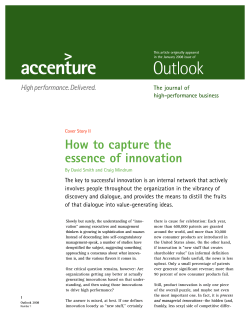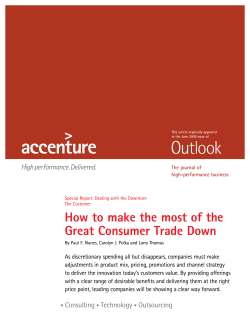
How to create the specialized workforce skills that transform Going deep
This article originally appeared in the May 2008 issue of The journal of high-performance business Talent & Organization Performance Going deep How to create the specialized workforce skills that transform talent into high performance By Donald B. Vanthournout and Maeve Lucas If a company is to leverage its workforce to create a distinct competitive advantage, it must develop a strategic talentmanagement function that can advance its employees faster and more reliably along a clearly defined path. Around the world, senior executives in every industry are hearing strong and consistent messages about workforce talent as a key to achieving and sustaining high performance. But what happens when those who take the talent message to heart decide to do something about it? 1 Outlook 2008 Number 2 Their first stop will be their HR and learning organizations—where they are likely to discover a painful contradiction. a company’s competitive position will probably come from employees with deeper and more specialized skills, a large percentage of enterprise learning investments are, in fact, often directed at providing training to those just learning a new skill or job. Imagine an architecture firm looking to reinvent an urban landscape but investing only in its apprenticeship program, and you have some idea of the problem. Although the game-changing innovations and transformational initiatives that can redefine If a company is to transform its talent into a distinctive capability—something identified by Accenture’s ongoing research as a building block of high performance— it must create a strategic talent management function that can advance its employees faster and more reliably along a clearly defined path—from novice-level capabilities to more advanced levels characterized by deeper and more specialized expertise. have altered the relevance and applicability of the information we retain to the work we actually perform. One study, for example, found that 20 years ago, about 75 percent of the knowledge needed to perform a typical job was stored in the worker’s mind; today, that number is less than 10 percent. Precisely what is deep specialization? The definition will vary according to the job being performed or the domain being learned. In a sales force, deep specialization might mean the ability to understand a customer’s industry thoroughly enough to recommend suites of solutions rather than just a list of products. For a pharmaceutical R&D function, it might mean conceiving and executing a new course of research rather than simply performing steps directed by another researcher. According to another study, less than 30 percent of workplace performance is knowledge- or skill-related—that is, the result of applying identifiable lessons from a formal learning experience to an actual job goal. But regardless of its specific meaning in terms of a particular skill domain or job, the broader, more strategic reason for developing specialized skills is to create workforces more prepared to innovate, to open new markets, to find new ways to serve customers better or more efficiently. For that to happen, however, companies must bring more structure and rigor to bear on a host of activities— from mentoring to on-the-job experience to collaboration—that take the organization and its people well beyond the boundaries of traditional, formal training. Does all this mean your company is currently not investing in the kinds of training needed to transform your most important workforces into a distinctive talent capability? Investments versus impact Understanding the current disconnect between workforce investments and the practices that actually result in better business performance requires a bit of background on how the typical work environment has changed during the past few decades. It’s also useful to review what we know about workforce enablers that have an impact on performance. 2 Outlook 2008 Number 2 Recent research suggests that the demands of the knowledge economy The other approximately 70 percent is influenced by informal learning and by other factors in a worker’s environment—feedback, coaching, leadership, incentives, clear work objectives and processes, and so forth. Chances are it does. About 80 percent of a typical company’s people development budget is indeed spent on formal learning, and only 20 percent on the informal learning and support environment that has been shown to have greater impact on workforce and, by extension, company performance. Advancing toward more specialized skills and capabilities is not the same thing as advancing up the career ladder. More typically, employees’ skills grow and become increasingly specialized at one level of their careers; when they take the next step up the ladder, however, they may become beginners again. Experienced workers on an auto assembly line may become highly adept at a specific task, but when they get promoted to a supervisory position, suddenly they’re novices at a new critical skill: managing groups of employees. The path to deep specialization To attain specialization, workers would normally pass through five levels of development. But the typical company’s workforce enablement budget is spent on getting employees only to Level 2. Behavioral characteristics Level 5 Expert • Operates at a level of knowledge and expertise that is unique or rare in the company and/or the industry • Creates new approaches, improves processes and seeks out new business opportunities Level 4 Advanced • Has mastered knowledge and processes of a domain • Is effective in complex situations and capable of innovation • Has a broad perspective and can mentor those at lower levels Level 3 Independent • Initiates work and seeks input only when needed • Requires minimal guidance and coaching • Solves routine problems or issues that deviate from established processes Level 2 Proficient • Can follow an established process • Works inefficiently and with limited flexibility • Requires frequent oversight and guidance Level 1 Novice • Needs help initiating work steps • Mistakes are common, and frequent guidance is required Source: Accenture analysis The path to specialization The path to deep specialization can be defined in general terms, however. Consider the chart on the opposite page, which shows the developmental path taken by a person who begins a new job, takes on a new role or learns a new work domain. At the first, or “novice,” level, workers begin from a position of minimal understanding of what their performance goals are and how they are supposed to reach those goals. Mistakes are common. Through a combination of training and practice, they rise to the second, or “proficient,” level. Now they understand what they are doing and, for the most part, why, but they still often perform inefficiently. They require a great deal of oversight, and generally must follow a carefully prescribed path to accomplish their work. 3 Outlook 2008 Number 2 Workers who reach the third, or “independent,” level clear a hurdle that means a great deal to their personal productivity and the productivity of their organizations: They can work independently much more of the time. They have a good sense of the “landscape” of their jobs, see the various destinations that are a part of their performance, and only occasionally need the guidance of a supervisor to reach those destinations. When employees attain the higher levels—“advanced” and then a stage where they can truly be considered “expert”—they are no longer simply following set paths. They are also occasionally reinventing those paths— creating ideas for new products and services; devising business strategies with the potential to redefine their industry; coming up with new ways of serving customers, new markets, new customer bases; and so forth. At the very highest level, these experts may have truly unique specialized skills and a reputation—inside and/or outside the organization—as deeply knowledgeable practitioners and innovators. To be sure, not every person is going to advance inexorably upward in this manner. Workers may lose interest in a particular area or job, or they may not have the ability to learn the skill or perform at advanced levels. (Applied to career advancement, this is where the famous Peter Principle—the tendency of organizations to promote people to their level of incompetence—comes into play.) Advancing toward more specialized skills and capabilities is not the same thing as advancing up the career ladder. It is nonetheless critical to make the right kinds of enablers available to employees so that those with the interest in and innate capacity for a particular skill have the best chance possible to advance and succeed— and so that the company as a whole develops people with deeper skills and, by doing so, gains a competitive advantage. Again, most organizations are not investing properly in those enablers. In fact, significant percentages of a typical company’s workforce enablement budget are being spent to get people only to a level of proficiency (Level 2). The enablers—all the classroom and online learning, the practice, the availability of knowledge assets—get people only to the point at which, most of the time and given enough attention from a supervisor, they can perform most of their tasks correctly. That is not a blueprint for creating a distinctive talent capability that sustains high performance. The limitations of traditional learning often come as a shock to line managers looking for a training solution to their workforce performance challenges. 4 Outlook 2008 Number 2 Mary Jo Burfeind, who leads learning and development for the Subscriber Services Division of Health Care Service Corporation, notes that the company’s managers sometimes expect that when their employees come out of formal learning programs, they will be self-sufficient and capable of independent problem solving. “But that is rarely the case,” says Burfeind. “The training that our claims and customer service people receive, for example, is really about getting them to a level of basic proficiency.” After that point, moving those same employees to a level where they are acting independently or even coaching others requires them to be continuously learning on the job—getting guidance, learning from their experiences and talking to their peers. Constraints Learning organizations may struggle to figure out how to provide the enablers for deeper specialization, given the constraints under which they operate. Continues Burfeind: “As employees grow and develop, and as their jobs become more complex, it really is as if they’ve graduated. We don’t see them again except on occasion. The learning organization is less actively involved in their development.” However, as Burfeind says, “It’s really during those years when a degree of directed development activity could have the most effect on their individual performance, and on the impact they make on the company. So we’re working to take advantage of that dynamic by planning more targeted learning activities for incumbents.” A fuller suite of enablers The development of a distinctive talent capability depends on two things. First, management must understand the different kinds of learning opportunities that can help workers attain deeper levels of specialization. Second, the company must apply the same kind of organizational and process rigor to those opportunities as they are accustomed to applying to their formal training programs. A specialization roadmap Such a roadmap plots the progression of an employee from novice to expert in the context of the actual programs and activities within each of the three categories of specialized learning. Formal learning Collaboration Guided experience Level 5 Expert • Teach classes and identify needs for new learning assets • Pursue executive education courses • Sponsor a community of practice • Participate in an external industry association or executive forum • Increase personal capability by serving as the go-to person in the relevant subject area • Mentor others, especially advancedlevel employees Level 4 Advanced • Serve as a subject-matter expert for development projects • Volunteer to teach courses • Host a blog or contribute to a community of practice • Provide guidance as a team leader • Volunteer to be a mentor, both formally and informally • Spend time interacting with employees on the front lines, observing and sharing experiences Level 3 Independent • Enroll in advanced training for this content area • Teach colleagues informally (brown-bag discussions, etc.) • Contribute to a corporate knowledge base • Actively share experiences with peers during the course of performing work • Contribute to discussions within a community of practice • Actively pursue a relationship with a mentor and coach • Work with a supervisor to pursue stretch activities and roles to expand basic competency Level 2 Proficient • Enroll in beyond-the-basics training programs • Access relevant knowledge sources, tools and methods • Closely observe others while collaborating to perform tasks • Actively ask questions of others • Seek assignments and project roles to become more familiar with basic work processes and tasks • Seek guidance from more experienced peers to improve the ability to address new challenges Level 1 Novice • Enroll in basic-level training • Review relevant knowledge sources • Share experiences with other novices • Seek out experiences of others • Ask a coach or supervisor for guidance on specific tasks • Adopt the mindset that mistakes are part of the learning experience; apply lessons to the job Helping myself grow by helping others grow Advancing my knowledge and basic capabilities Source: Accenture analysis 5 Outlook 2008 Number 2 The full suite of enablers to advance workers toward deep specialization includes programs in three basic categories. advanced or expert status in a particular area, companies must also create programs in the following two areas. 1. Formal learning. This includes traditional training programs in a classroom or via e-learning, as well as access to reference information and knowledge. Recall, however, that today, such formal learning really only supports less than 30 percent of the performance requirements of a typical knowledge worker’s job. To move workers beyond proficiency to 2. Guided experience. Experience is the best teacher, but simply throwing workers into an experience without guidance or structure is not an efficient way to proceed. By analogy, flailing away at the ball for several hours a day is one way to “experience” playing tennis, but one can achieve higher levels of performance more rapidly by working with a coach. So organizations must put in place the processes by which workers can mine the lessons of actual on-thejob experience, and then use those learning experiences to improve subsequent performance of similar tasks. Another essential part of onthe-job experience is the feedback and guidance (both reinforcing and corrective) a worker receives from a coach and/or mentor. Other ways of formalizing the experiential dimension of learning include actual apprenticeships, which link formal learning to experience in a phased development process. (For a related article, see “Turning experience into leadership,” Outlook, January 2008.) 3. Collaboration. The value of collaboration is about more than simply accomplishing a common task. “Co-laborers” are also “co-learners.” Individuals learn in real time as they observe others successfully accomplishing a task. They also learn as they share with one another how they met a particular performance challenge. Creating the “whole that is greater than the sum of the parts” through collaboration is part of developing a distinctive talent capability. Jim Demme is the program manager for the Learning Center at Grainger, a leading distributor of facilities and maintenance supplies. He notes that this combination of formal training with other, experiential learning opportunities is important because it more faithfully reflects the real work environment. In Grainger’s case, such a combination of enablers helps sales and service employees develop more specialized capabilities. 6 Outlook 2008 Number 2 Says Demme, “We can sit our people down in a classroom, but until they actually go on-site to a customer’s location and implement one of our solutions, it’s all theoretical to them. They have to experience it.” That’s why Demme and his learning colleagues try to be as direct as they can about the on-the-job experiences and guidance they need on top of the formal training. Only with those experiences, he points out, “will they ever be able to say, ‘Now I understand the steps in solving not just this one problem but any similar type of problem.’ And that’s when we can say they’ve achieved the kind of independent and advanced performance status we need from them so they can better serve our customers.” Several activities and strategies are crucial to being more purposeful and deliberate about moving employees forward on the path to advanced or expert status—and, in so doing, creating a distinctive talent capability. Create a specialization roadmap The five-step path to specialization is a generic one, of course, so it is important to translate the general “path” into what we call a specific “roadmap.” This defines what the various levels mean for a given job, putting in place the enablers that can most effectively advance workers toward those levels, and accurately assessing when a worker has achieved a new level of specialization. As shown in the chart on page 99, such a roadmap plots the progression of an employee from novice to expert in the context of the actual programs and activities within each of the three categories of specialized learning just discussed. It makes the steps needed to achieve deep specialization both explicit and actionable. As an example of how such a roadmap works in practice, consider the actual case of a senior executive charged with transforming the project management capabilities for the managers of a large multinational. When the executive first came to his learning organization for help, he requested a comprehensive training curriculum. But faced with the growing realization that formal learning could not, almost by definition, accomplish his goal of transforming independent and adequately skilled workers into deeply skilled, expert project managers, he became discouraged. Eventually, however, using a specialization roadmap, the executive was able to work with his learning professionals to put some compelling plans in place for leveraging coaching, collaboration and on-the-job experiences to advance the managers toward deeper expertise. For example, those workers performing at a proficient level (Level 2), were encouraged to tap into the experience of others by participating in “communities of practice”—informal groups meeting monthly by phone to exchange best practices and lessons learned. Employees who had already achieved the independent level (Level 3) were provided with specific stretch goals (leading a new project or process, for example) to expand the scope and responsibility they would typically take on in this area. Those who had reached advanced status (Level 4) were asked to serve as mentors to others. This not only helped less experienced colleagues, it also helped advance these Level 4 employees toward expert status— since research has shown that teaching others is a critical part of achieving expertise in any field. Create rigor and structure around what experience and collaboration really mean 7 Outlook 2008 Number 2 It is certainly true that the skills needed to perform at an advanced or expert level become more difficult to define. But they do not become totally mysterious or magical either. Organizations that are serious about creating a distinctive talent capability need to provide as much structure as they can around the activities beyond formal learning, including coaching, collaboration and mentoring. As Health Care Service Corporation’s Mary Jo Burfeind puts it, an effective mentoring program depends on specific definitions of the competencies and skills required. “And then we have to find out who’s good at it already and who needs help, which means we also need the means to perform accurate assessments of our mentors’ current performance. As we move forward, we will be looking to use tools such as leadership surveys or 360-degree feedback tools to make our mentoring program more structured and data-driven.” It’s also important to be as specific as possible about what “expertise” means, even for very complex skills. For example, Talethea Best, director of US talent development for Aon Corporation, has been involved in the creation of several new executive development programs for her company. “We’re at the point,” she says, “where we need to take to the next level our ability to specify exactly what it means to say that someone is ‘better’ than someone else at a complex activity, such as crafting business strategy. To me that means identifying the executives who have demonstrated their effectiveness at being global strategists, tapping into what’s in their heads and exposing others to that knowledge and that approach.” What you end up with is some-thing that at least approaches what Best calls a “curriculum for on-the-job experience.” “It’s not formal training,” she says, “but it’s extremely active and hands on. A less experienced person brings their draft business plan or strategy to the conference table and gets feedback from more experienced executives. Ultimately this is about forging ‘thinking part- nerships’ with experienced executives so others can benefit.” goals. A realistic assessment of the employees’ critical skills must be made, and those assessments must be matched against management’s expectations. Coordinate action among all the important stakeholders This communication about expectations is often overlooked. When more specifics are provided, employees frequently respond positively. It’s as if they are saying, “No one ever told me before what I needed to do to improve my performance or reputation in this area.” Career counselors play an important role in providing feedback on the self-assessment and setting the right expectations. For individuals to build deeply specialized skills, they need clarity, direction and support from several quarters. • Organization leadership must define the body of knowledge that underpins and guides a specialty area (found in books, specific research, best practices) and then— as alluded to in Best’s example of crafting business strategy—define and communicate expectations about the necessary skills and experience. Then leadership must work with learning professionals to devise strategies for developing deep skills in the target group. Tracking mechanisms also need to be put in place to measure the program’s effectiveness. • Career counselors should assist in setting employees’ development • Supervisors must actively look to give individuals on their teams the opportunity to deepen their proficiencies through on-the-job learning and “stretch” assignments. They must also provide regular performance feedback, optimally in real time rather than waiting for an annual performance review. Perhaps most important, supervisors need to allot sufficient time and resources for their employees to engage in the new kinds of learning required to become deeply skilled. The key stakeholders, of course, are the employees themselves. A distinctive talent capability must now be seen as an outcome of that “thinking partnership” between an organization and its people. Executive leadership, for its part, must become much more purposeful and structured about what the path to deep specialization looks like for critical jobs and roles, and about how to move people along that path. At the same time, successful employees will be those who proactively and independently seek out new experiences and learning opportunities, new relationships with mentors and coaches, and new kinds of collaborations with colleagues. The willingness to learn new things and to take on new experiences can now be seen as something critical to the success of employees and the organizations they work for. 8 Outlook 2008 Number 2 About the authors Donald B. Vanthournout is Accenture’s chief learning officer and the head of Accenture Education, the company’s capability development organization. He is the author of Return on Learning: Training for High Performance at Accenture (Agate, 2006). Mr. Vanthournout is based in Chicago. don.b.vanthournout@accenture.com Maeve Lucas is a Chicago-based senior manager with Accenture Education, where she oversees the development and implementation of learning strategies across Accenture’s consulting, enterprise and outsourcing practices. maeve.lucas@accenture.com Outlook is published by Accenture. © 2008 Accenture. All rights reserved. The views and opinions in this article should not be viewed as professional advice with respect to your business. Accenture, its logo, and High Performance Delivered are trademarks of Accenture. The use herein of trademarks that may be owned by others is not an assertion of ownership of such trademarks by Accenture nor intended to imply an association between Accenture and the lawful owners of such trademarks. For more information about Accenture, please visit www.accenture.com
© Copyright 2025





















